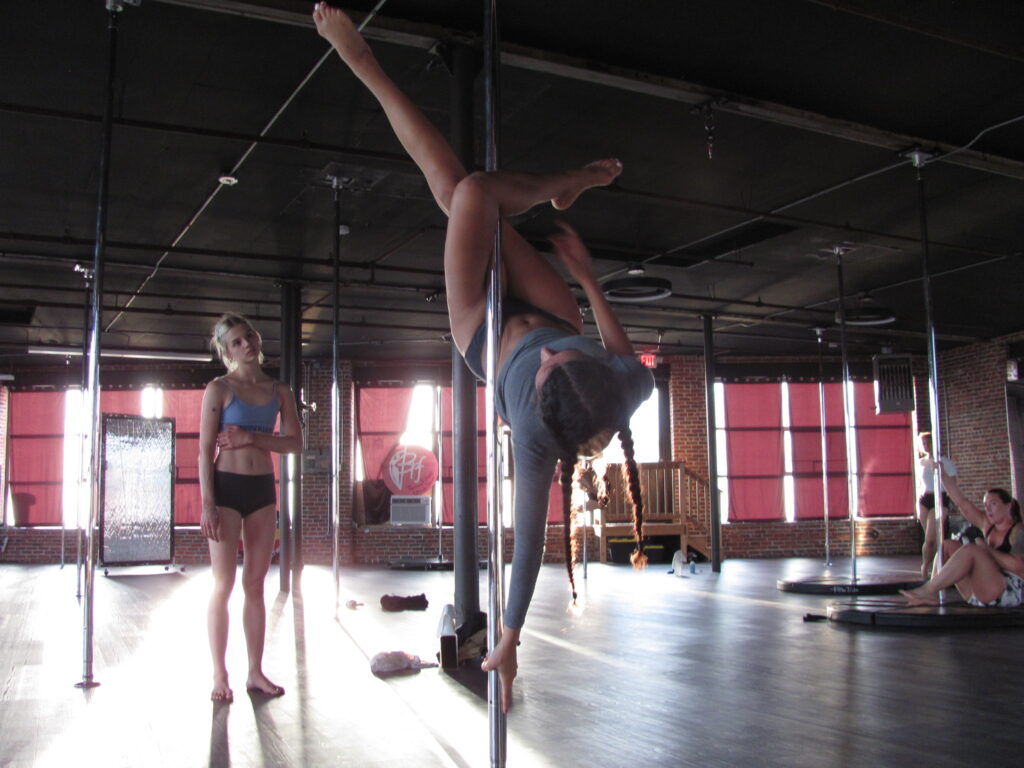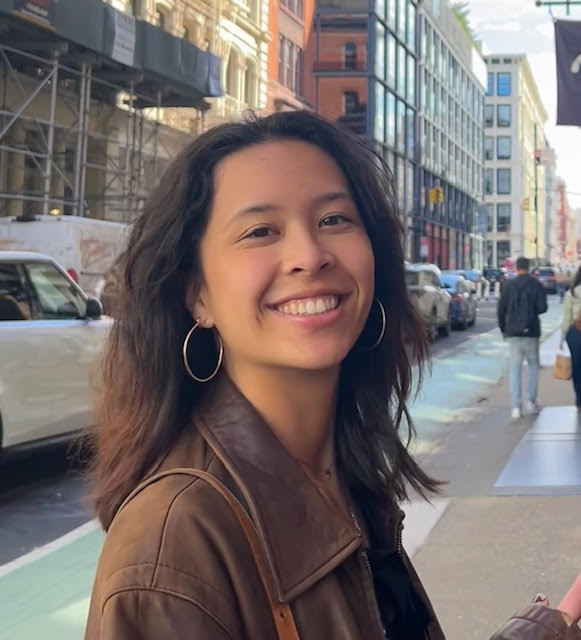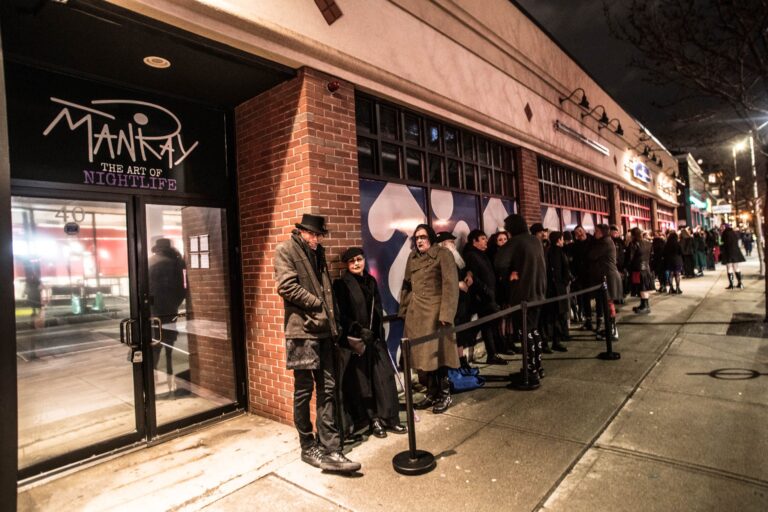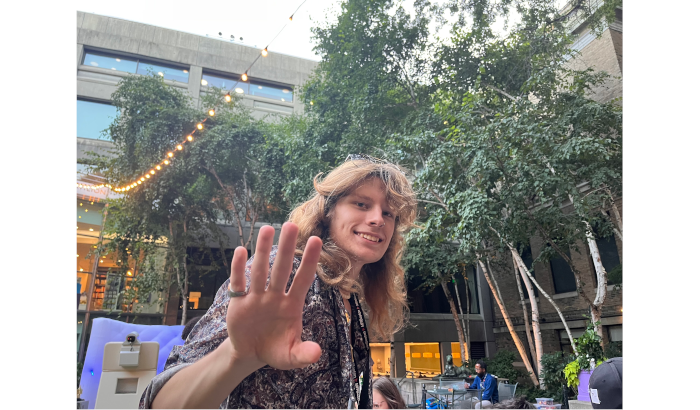Pole dance in Massachusetts—beyond and within its sensual origins
I decided to take a pole dancing class. I didn’t take it to learn a sexy dance to show a romantic partner, to fulfill my stripper aspirations, or because it was someone’s choice of birthday party venue. Before this year, those were the only reasons I knew of to take a pole dancing class.
I found myself at a Boston Pole Fitness studio in Dorchester this past November because I realized, after my friend Mailey Baer started taking weekly classes there, that there was so much more to pole dancing than its origin of sex work and stripping.
Pole dance has expanded: it’s a space for community, a body positivity movement, an outlet for dancers looking for a different way to move, and an alternative fitness routine.
The visibility of pole dance has increased through pole dancers posting their moves on Instagram and TikTok. Youtube tutorials allowed novice dancers to try pole dancing at home during the pandemic. Movies like “Zola” (2021) and “Anora” (2024) have opened audiences up to the perspectives of sex workers and strippers.
Other styles of pole exist internationally that don’t have sexual origins, like Chinese Pole or Mallakhamb from India. But in the U.S., it began as a sexual performance by women for men. From “hoochie coochie” dancing on circus tent poles to Burlesque dancing to strip clubs, pole dancing has deeply sensuous and performative roots. Then North America’s first pole studios opened up in the early 2000s, making it more accessible to hobbyists rather than only strippers according to Vox.
This history of pole, however, is not something that today’s pole dancers are looking to detach from. They’re open about it and appreciative of how their beloved dance started. “It’s just as valid if it’s sexy or not,” BPF instructor Angel Diaz said. “But it came from people doing it sexy so let’s not forget that.”
I didn’t feel very sexy in my beginner class, but there’s no doubt that I was challenged.
No matter how hard I gripped the pole, both of my hands (slick with sweat) couldn’t hold up my entire body weight. I defeatedly slid to the floor over and over again just trying to do a single spin. My body was somehow supposed to have three points of contact with the pole? A hand, inner leg, and back of ankle?
But then I jumped up, interlocked my legs, and my body swung around the pole. “You got it!” Isadora, 24, the class instructor said.
“[Pole] pushes you out of your comfort zone and challenges how you view your body, health-wise and psychologically,” Isadora said. “There’s a certain power to it.”
This power is why pole dancing attracts all kinds of people, Mændy Mac, 42. She’s the owner of Pole in the Wall dance studio in Springfield, Massachusetts and co-host of the Pole on the Call podcast. “We have dancers of all genders, from ages 18 to 65. Many are in healthcare, some are teachers, and only about 5 percent are in the sex worker industry,” Mac said in an email.
In Massachusetts there are at least 13 pole dance studios, according to a survey by the International Pole Industry Association. Boston Pole Fitness, with locations in Dorchester, Brighton, and Newton, is a local example of the variety of ways people use pole dance.
Before one of her Mixed Pole Tricks and Combos class in late September, BPF instructor Diaz, 24, warmed up. She spun around with her hands circling the middle of the pole and her legs extended in a vertical split. She told me she always feels a spiritual connection when she’s on the pole. It doesn’t matter if she’s on stage, teaching a class, or alone in the studio. All that matters is her and the pole.
“Take your time, this is good for stabilization,” Diaz said, as she led the class step-by-step through stretches for the first ten minutes of class. High energy pop music blasted through the room.
Then, Diaz was on the pole, her long dark braids swinging as she demonstrated moves. Her four students followed her instructions, shaping their bodies into moves like brass monkey (hanging upside down with the pole tucked under the back of one knee), jasmine (one leg hooked around the pole with the other extended horizontally), or genie (both legs hooked around the pole with feet pointed towards one another).
Diaz walked around the studio, offering encouragement and advice to each student as they hung upside down or interlocked their limbs around the pole—sometimes Diaz would manually adjust their legs or arms for them while explaining why it would help them.
From her first pole dancing class at BPF two years ago to the classes she teaches there now, Diaz has been “obsessed” with pole.
“It’s everything,” Diaz said. “It’s literally everything. I do it every single day.”
She specializes in stripper-style dancing, with choreography and sometimes six-inch heels that make her 6 ‘5 tall. When she dances, she said it’s as if the pole is an extension of herself.
She teaches her students, especially women and the queer community, to have an awareness of their bodies and the value they have to take up space.
“We’re just taught to make ourselves small,” Diaz said. “But in order to spin, you have to take up space. So take up space.”
Diaz remembers doing ballet as a child and struggling to stand in one place at the bar, which she told me got her dismissed from the program. Pole dance, she said, has healed her relationship with dance.
“If you train for a certain number of hours a week, inherently, you’re gonna improve,” Diaz said. “I have students like Mailey—she puts in the work, she puts in the time, and you can see it.”
Mailey Baer, 20, is one of Diaz’s regular students, and was one of the four at her Mixed Pole Tricks and Combo class. After watching Diaz demonstrate, Baer paused for a moment with her hands resting on the pole. The mirror in front of her (one of the several that can be moved around the studio on wheels) reflected her face deep in concentration. She told me she was mentally visualizing herself completing the move.
Pole consistently challenges her mind and body, she said, and that’s what keeps her coming back to the studio twice a week.
“I’m like ‘Oh my god, I can’t do that, I can’t do that, I can’t do that.’ And then I do it. And I’m like ‘Oh my god, yay.’ Then it just makes me want to do it more,” Baer said.
Baer has been dancing almost her whole life, from ballet at three years old to contemporary in an Emerson College dance group. She loves dance, but the rigidity and pressure to perform drew her away from those styles. She said she wanted a more empowering outlet.
After hearing about it from a friend, Baer took her first pole class at a studio back home in LA. Once she returned to Emerson College in Boston, she quickly found BPF to continue her practice.
“I feel like I’ve gotten a new appreciation for what my body can do and just new challenges,” Baer said. “It’s just super exciting and it’s challenging and it makes me want to get better. It works my brain in a different way.”
Clothing is limited during pole classes, because their grip relies on skin-to-pole contact. Despite this, Baer told me pole has helped her regain confidence in herself and her body because of an encouraging environment.
“Even though, yeah, you are looking at yourself and you are in very little amounts of clothes. . .” Baer said. “It’s just super not-judgy at either studio I’ve been to in any class.”
On the other end of the pole spectrum, Ashley Dreimiller, 36, doesn’t even consider what she does on the pole to be dancing. Instead of relying on choreography, she performs tricks-based pole: the style she most enjoys and teaches for intermediate and advanced students.
She jokes that she has “a whole fake PhD in anatomy just from doing pole. My transverse abdominal muscle, my obliques, and primary hip flexors are huge, and then shoulder engagement, working on your traps and keeping your rhomboids healthy.”
In 2017, the Global Association of International Sports Federation declared pole an internationally recognized sport, according to the Washington Post. Most recently, it’s been debated to become an Olympic sport, due to the amount of strength and skill it requires.
Dreimiller can lift her entire body off the ground, with only her hands clutching the pole. This move, a deadlift, is one of Dreimiller’s go-to positions in Pole Sport Organization (PSO) competitions.
“Nobody really cares whether or not you do choreo,” Dreimiller said. “They’re just too busy being like, ‘Wow, how did you do that?’”
She started pole dancing in her twenties, as a student at BPF. To counter the cost of attending classes, she started teaching—and came to love it. Now it’s the only time she does pole.
“There were certain things that I felt were not explained well to me that I had to figure out myself as a poler,” Dreimiller said. “Being able to pass those insights on to students is really what I find fun.”
Before finding the niche of pole she connected with the most, Dreimiller tried just about every other avenue. Sporting high heels and thick lashes, she performed in various shows, was onstage with music artists, and gogo danced in a now-closed club. In November 2019, she won the PSO National Competition.
Dreimiller said PSO contestants pay to perform and can choose whether or not they want to be judged. If they do, they get feedback from a panel of judges via email. Competitions take place in all regions of the country every year and are broken down into categories like skill tricks or flow dancing. All genders, ages, and experience levels compete against one another in front of an audience of supporters and peers.
The medal Dreimiller won didn’t mean much more to her than a supplement to her teaching credentials. For her, pole is a way to stay active without being in a gym environment.
She’s regularly found doing dynamic strength- based moves: handsprings, Phoenixes, and deadlifting.
Dreimiller encourages people new to a city to take a class, as a chance to socialize. “If you’re the kind of person who needs to be motivated by a community to stay active, that’s one of the really great benefits of pole,” Dreimiller said.
Within the community, Dreimiller said there’s a risk of pole dancers being pigeonholed into only one style of pole, which she makes an effort to unteach in her classes, where she usually plays music by Beyonce.
“I just had a conversation with a student who was like, ‘I don’t know what to do next, because I dance sexy and I don’t want to dance sexy,’ Dreimiller said. “I was like, ‘Who told you that you have to?’”
The body, as an art or as a mass of muscles, is central to pole dancing, along with the pole, of course. Dreimiller recognizes the way pole dancing encourages people to advocate for themselves—feelings about self-ownership, your body, and how you use it.
Pole is not just for women. Data engineer Lawrence Lai, 31, is very aware of what he uniquely brings into the studio as a straight man. He occasionally takes classes at BPF, but mostly just takes advantage of their open practice times.
“There’s some strengths that come with being a guy, there’s also some lack of flexibility,” Lai said. Growing up as a boy in ballet, he’s used to the judgement that comes with doing a stereotypically feminine activity. He likened pole dancing to weightlifting or crocheting, activities that are needlessly gendered.
“Pole dance is pole dance, anybody can do it,” Lai said.
His ex-girlfriend convinced him to try pole dancing, back in August 2021. Their relationship ended, but his bond with pole dance did not. Since then he’s won a PSO competition, with an athletic piece that incorporated martial arts movements.
“There is also a very intentional effort to make the routine extremely masculine to match my identity, as well as set myself apart from other competitors,” Lai said.
He shared a video of his PSO competition piece with me. In one part, he bounds around the pole, then lifts off with ease and floats in a circle before landing with a foot secured on the pole and his opposite leg hooked around it. Spreading out his arms, he proudly holds the pose.
“I’m trying to push the limits of my body … and show it off,” Lai said. “During performances you’ll see me mostly doing difficult tricks.”
Competitive, strength-based style is his specialty. He said he doesn’t put any thought towards looking pretty or sexual.
During an open practice session at BPF’s Newton location, he and Kenna Blume, 21, practiced duo moves. Lai hung by one leg upside down, with the other extended. Blume was upright, hanging from that leg with one hand and holding onto the pole with her other hand, with her leg hooked around it.
Blume is a former ice skating competitor, a sport she left because of the intensity and stress. She found out about pole dance on Instagram, and was instantly hooked. Now she teaches a variety of classes at BPF: Intro to Pole, Transition to Beginner Level, Mixed Tricks, and has even subbed for a twerk class. Her favorite classes to teach are the beginner ones, because she said wants to give people a warm welcome to the pole community.
“I preach pole dancing because I love it so much,” Blume said. “I really felt like instructing would be my way into … spread[ing] the love of pole.”
Blume has a tattoo of a pole dancer on her back—that’s how much she loves it. She offers private lessons, helps fellow pole dancers choreograph pieces, teaches at BPF and the Brandeis University pole club, all while being a senior at Emerson College.
She emphasizes the dance part of pole dancing, and said she loves to show off her body. But what she encourages her students to do is find the type of pole that’s right for them.
“You don’t even have to come to class to be sexy and grinding on the pole,” Blume said. “A lot of people do. A lot of people just go for the tricks. A lot of people just go for the community. Some people say it gets them out of bed.”
There’s some tension within the pole community about respecting its alternate avenues. She explained to me that #notastripper was popular on social media a few years ago, and still comes up now and then.
“I can’t understand why people would post that,” Blume said. “It’s just so offensive to be like, ‘I’m doing something that comes from stripping, and I love it, but I’m not like them.’”
When she talks about pole, she always makes sure to acknowledge the strippers it started with. She also always tries to convince more people to try it out.
“You got to get a class pack and force yourself to use it all,” Blume told me. “It’s so good for you. It’s good for the soul.”
Blume recently directed her first pole show, Rocky Horror Picture Show, at BPF. She described several moments where she felt clarity, instead of dissociating like she would when ice skating.
“I looked over and the audience is cheering, because they’re like, ‘Oh, you’re in a split, that’s so cool,’” Blume said. “In my head, I’m like, ‘Oh, they don’t even know I’m about to do something even cooler. I’m about to drop.”
When I joined Lai and Blume at the open practice session, I asked her if she could show off her drop. It’s as it sounds—Blume grips the pole with a thigh and underarm while in a split, then releases the pole for a second, and drops. Then she hooks her leg, quickly catching herself.
Days before she’d told me, “I feel so strong when I’m on a pole. I feel brave and sexy.” She wasn’t feeling her best that day in the studio, but if she hadn’t told me I never would’ve thought that. Every time she slipped or stumbled, she’d pull herself back up and try again with a smile.
This article was produced for HorizonMass, the independent, student-driven, news outlet of the Boston Institute for Nonprofit Journalism, and is syndicated by BINJ’s MassWire news service.






